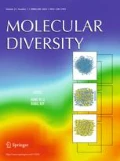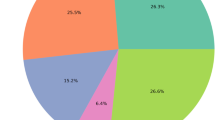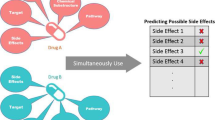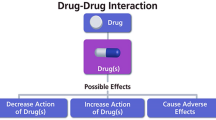Abstract
Amphetamine-type stimulants (ATS) drug analysis and identification are challenging and critical nowadays with the emergence production of new synthetic ATS drugs with sophisticated design compounds. In the present study, we proposed a one-dimensional convolutional neural network (1DCNN) model to perform ATS drug classification as an alternative method. We investigate as well as explore the classification behavior of 1DCNN with the utilization of the existing novel 3D molecular descriptors as ATS drugs representation to become the model input. The proposed 1DCNN model is composed of one convolutional layer to reduce the model complexity. Besides, pooling operation that is a standard part of traditional CNN is not applied in this architecture to have more features in the classification phase. The dropout regularization technique is employed to improve model generalization. Experiments were conducted to find the optimal values for three dominant hyper-parameters of the 1DCNN model which are the filter size, transfer function, and batch size. Our findings found that kernel size 11, exponential linear unit (ELU) transfer function and batch size 32 are optimal for the 1DCNN model. A comparison with several machine learning classifiers has shown that our proposed 1DCNN has achieved comparable performance with the Random Forest classifier and competitive performance with the others.
Graphic abstract













Similar content being viewed by others
References
Christophersen AS (2000) Amphetamine designer drugs – an overview and epidemiology. Toxicol Lett 112–113:127–131. https://doi.org/10.1016/S0378-4274(99)00205-2
Blickman T (2009) The ATS boom in Southeast Asia. In: Withdrawal symptoms in the golden triangle - A drugs market in disarray. Transnational Institute
Carroll FI, Lewin AH, Mascarella SW et al (2012) Designer drugs: a medicinal chemistry perspective. Ann N Y Acad Sci 1248:18–38. https://doi.org/10.1111/j.1749-6632.2011.06199.x
Liu L, Wheeler SE, Venkataramanan R et al (2018) Newly emerging drugs of abuse and their detection methods: an ACLPS critical review. Am J Clin Pathol 149:105–116. https://doi.org/10.1093/AJCP/AQX138
Peters FT, Martinez-Ramirez JA (2010) Analytical toxicology of emerging drugs of abuse. Ther Drug Monit 32:532–539
Harper L, Powell J, Pijl EM (2017) An overview of forensic drug testing methods and their suitability for harm reduction point-of-care services. Harm Reduct J. https://doi.org/10.1186/s12954-017-0179-5
Chung H, Choe S (2019) Amphetamine-type stimulants in drug testing. Mass Spectrom Lett 10:1–10. https://doi.org/10.5478/MSL.2019.10.1.1
Regester LE, Chmiel DJ, Holler MJ et al (2014) Determination of designer drug cross-reactivity on five commercial immunoassay screening kits. J Anal Toxicol 39:141–151. https://doi.org/10.1093/jat/bku133
Stumpfe D, Bajorath J (2011) Similarity searching. Wiley Interdiscip Rev Comput Mol Sci 1:260–282. https://doi.org/10.1002/wcms.23
Bero SA, Muda AK, Choo YH et al (2017) Similarity measure for molecular structure: a brief review. J Phys Conf Ser. https://doi.org/10.1088/1742-6596/892/1/012015
Krasowski MD, Ekins S (2014) Using cheminformatics to predict cross reactivity of “designer drugs” to their currently available immunoassays. J Cheminform 6:1–13. https://doi.org/10.1186/1758-2946-6-22
Willett P (2020) The literature of chemoinformatics: 1978–2018. Int J Mol Sci 21:1–9. https://doi.org/10.3390/ijms21155576
Shultz TR, Fahlman SE (2017) Encyclopedia of machine learning and data mining
Hu M-K (1962) Visual pattern recognition by moment invariants. IRE Trans Inf Theory 8:179–187. https://doi.org/10.1109/TIT.1962.1057692
Mamistvalov AG (1998) N-dimensional moment invariants and conceptual mathematical theory of recognition n-dimensional solids. IEEE Trans Pattern Anal Mach Intell 20:819–831. https://doi.org/10.1109/34.709598
Flusser J (2006) Moment invariants in image analysis. Proc World Acad Sci Eng Technol Int J Comput Electr Autom Control Inf Eng 1:3708–3713. https://doi.org/10.5281/zenodo.1071752
Murugan A, Nair SAH, Preethi AAP, Kumar KPS (2021) Diagnosis of skin cancer using machine learning techniques. Microprocess Microsyst 81:103727. https://doi.org/10.1016/j.micpro.2020.103727
Zhang X, Yang J, Nguyen E (2018) Breast cancer detection via Hu moment invariant and feedforward neural network. AIP Conf Proc. https://doi.org/10.1063/1.5033394
Sommer I, Müller O, Domingues FS et al (2007) Moment invariants as shape recognition technique for comparing protein binding sites. Bioinformatics 23:3139–3146. https://doi.org/10.1093/bioinformatics/btm503
Kihara D, Sael L, Chikhi R, Esquivel-Rodriguez J (2011) Molecular surface representation using 3D Zernike descriptors for protein shape comparison and docking. Curr Protein Pept Sci 12:520–530. https://doi.org/10.2174/138920311796957612
Sit A, Shin WH, Kihara D (2019) Three-dimensional Krawtchouk descriptors for protein local surface shape comparison. Pattern Recognit 93:534–545. https://doi.org/10.1016/j.patcog.2019.05.019
Benouini R, Batioua I, Zenkouar K et al (2019) Fast and accurate computation of Racah moment invariants for image classification. Pattern Recognit 91:100–110. https://doi.org/10.1016/j.patcog.2019.02.014
Benouini R, Batioua I, Zenkouar K et al (2018) Efficient 3D object classification by using direct Krawtchouk moment invariants. Multimed Tools Appl 77:27517–27542. https://doi.org/10.1007/s11042-018-5937-1
Pratama SF, Muda AK, Choo YH et al (2017) ATS drugs molecular structure representation using refined 3D geometric moment invariants. J Math Chem 55:1951–1963. https://doi.org/10.1007/s10910-017-0775-3
Pratama SF, Muda AK, Choo Y-H, et al (2018) Using 3D Hahn moments as a computational representation of ATS drugs molecular structure. arXiv Prepr arXiv180206404
Kiranyaz S, Avci O, Abdeljaber O et al (2021) 1D convolutional neural networks and applications: a survey. Mech Syst Signal Process 151:107398. https://doi.org/10.1016/j.ymssp.2020.107398
Pratama SF (2017) Three-dimensional exact legendre moment invariants for amphetamine-type stimulants molecular structure representation. Universiti Teknikal Malaysia Melaka
Pratama SF, Muda AK, Choo YH, Abraham A (2018) Preparation of ATS drugs 3D molecular structure for 3D moment invariants-based molecular descriptors. In: Advances in intelligent systems and computing. Springer International Publishing, pp 252–261
Korn F, Pagel BU, Faloutsos C (2001) On the “dimensionality curse” and the “self-similarity blessing.” IEEE Trans Knowl Data Eng 13:96–111. https://doi.org/10.1109/69.908983
Xiao B, Xu Y, Bi X et al (2020) Heart sounds classification using a novel 1-D convolutional neural network with extremely low parameter consumption. Neurocomputing 392:153–159. https://doi.org/10.1016/j.neucom.2018.09.101
Riese FM, Keller S (2019) Soil texture classification with 1D convolutional neural networks based on hyperspectral data. ISPRS Ann Photogramm Remote Sens Spat Inf Sci 4:615–621. https://doi.org/10.5194/isprs-annals-IV-2-W5-615-2019
Gan J, Wang W, Lu K (2019) A new perspective: recognizing online handwritten Chinese characters via 1-dimensional CNN. Inf Sci (Ny) 478:375–390. https://doi.org/10.1016/j.ins.2018.11.035
Abo-Tabik M, Costen N, Darby J, Benn Y (2020) Towards a smart smoking cessation app: A 1D-CNN model predicting smoking events. Sensors (Switzerland) 20:1–18. https://doi.org/10.3390/s20041099
Sharma A, Malacaria P, Khouzani MHR (2019) Malware detection using 1-dimensional convolutional neural networks. Proc - 4th IEEE Eur Symp Secur Priv Work EUROS PW 2019 247–256. https://doi.org/10.1109/EuroSPW.2019.00034
Yunita Dewi F, Faza A, Prajitno P, Kusuma Wijaya S (2020) Stroke severity classification based on EEG signals using 1D convolutional neural network. J Phys Conf Ser. https://doi.org/10.1088/1742-6596/1528/1/012006
Srivastava N, Hinton G, Krizhevsky A et al (2014) Dropout: a simple way to prevent neural networks from overfitting. J Mach Learn Res 15:1929–1958. https://doi.org/10.1016/0370-2693(93)90272-J
Kingma DP, Ba JL (2015) Adam: A method for stochastic optimization. 3rd Int Conf Learn Represent ICLR 2015 - Conf Track Proc 1–15
Nair V, Hinton GE (2010) Rectified linear units improve restricted Boltzmann machines vinod. In: 27th International Conference on Machine Learning. pp 807–814
Clevert DA, Unterthiner T, Hochreiter S (2016) Fast and accurate deep network learning by exponential linear units (ELUs). 4th Int Conf Learn Represent ICLR 2016 - Conf Track Proc 1–14
Mesbah A, Berrahou A, Hammouchi H, et al (2018) Non-rigid 3D model classification using 3D hahn moment convolutional neural networks. Eurographics Work 3D Object Retrieval, EG 3DOR 2018-April:79–85. https://doi.org/10.2312/3dor.20181056
Kim P (2017) MATLAB deep learning: with machine learning, neural networks and artificial intelligence
Glorot X, Bengio Y (2010) Understanding the difficulty of training deep feedforward neural networks. J Mach Learn Res 9:249–256
Learning M (2014) Simple guide to confusion matrix terminology. 1–9
Kandel I, Castelli M (2020) The effect of batch size on the generalizability of the convolutional neural networks on a histopathology dataset. ICT Express. https://doi.org/10.1016/j.icte.2020.04.010
Radiuk PM (2018) Impact of training set batch size on the performance of convolutional neural networks for diverse datasets. Inf Technol Manag Sci 20:20–24. https://doi.org/10.1515/itms-2017-0003
Masters D, Luschi C (2018) Revisiting Small Batch Training for Deep Neural Networks. 1–18
Srivastava S (2014) Weka: a tool for data preprocessing, classification, ensemble, clustering and association rule mining. Int J Comput Appl 88:26–29. https://doi.org/10.5120/15389-3809
Ribani R, Marengoni M (2019) A survey of transfer learning for convolutional neural networks. Proc - 32nd Conf Graph Patterns Images Tutorials, SIBGRAPI-T 2019 47–57. https://doi.org/10.1109/SIBGRAPI-T.2019.00010
Ijjina EP, Chalavadi KM (2016) Human action recognition using genetic algorithms and convolutional neural networks. Pattern Recognit. https://doi.org/10.1016/j.patcog.2016.01.012
Zatarain Cabada R, Rodriguez Rangel H, Barron Estrada ML, Cardenas Lopez HM (2020) Hyperparameter optimization in CNN for learning-centered emotion recognition for intelligent tutoring systems. Soft Comput 24:7593–7602. https://doi.org/10.1007/s00500-019-04387-4
Acknowledgements
This work was supported by Fundamental Research Grant Scheme [FRGS/1/2020/FTMK-CACT/F00461] from the Ministry of Higher Education, Malaysia.
Author information
Authors and Affiliations
Corresponding author
Ethics declarations
Conflict of interest
The authors do not have any conflict of interest.
Additional information
Publisher's Note
Springer Nature remains neutral with regard to jurisdictional claims in published maps and institutional affiliations.
Rights and permissions
About this article
Cite this article
Mohd Yusof, N., Muda, A.K., Pratama, S.F. et al. Amphetamine-type stimulants (ATS) drug classification using shallow one-dimensional convolutional neural network. Mol Divers 26, 1609–1619 (2022). https://doi.org/10.1007/s11030-021-10289-1
Received:
Accepted:
Published:
Issue Date:
DOI: https://doi.org/10.1007/s11030-021-10289-1




